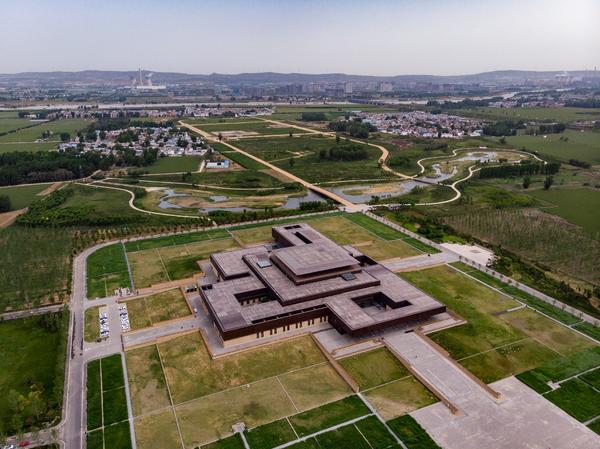Towards Civilization⑥|Discover earliest China at Erlitou site in Luoyang, Henan
"We should attach more importance to and put more efforts on archaeological research to carry forward the project of tracing the origins of Chinese civilization," stressed Chinese President Xi Jinping during his recent inspection tour to Anyang city, Henan province. Henan, cradle of the Chinese nation and civilization, is not only the birthplace of modern Chinese archaeology, but also the core area for tracing the origins of Chinese civilization. Together with the Development and Reform Commission of Henan Province and the Administration of Cultural Heritage of Henan Province, we are launching the "Towards Civilization" bilingual series featuring 13 key archaeological sites in Henan to help you catch a glimpse of wonderful Henan and brilliant Chinese civilization. Here is the 6th episode of the series: Discover earliest China at Erlitou site in Luoyang, Henan.
近日,习近平总书记考察了殷墟遗址,提出考古工作要继续重视和加强,继续深化中华文明探源工程。河南是中华民族和中华文明的重要发祥地,中国现代考古学从河南起步,中华文明探源从河南开始。2022年11月5日起,大河网联合省发展改革委、省文物局推出《追寻文明的足迹》系列报道,一起走进厚重河南。今日推出第六期:《最早的中国——洛阳二里头遗址》。
Click on the video
Luoyang city, in Central China's Henan province, is among the first group of historical and cultural cities as well as ancient capital cities designated by China's State Council in China, having served as ancient capital for 13 dynasties in Chinese history, including the dynasties of Xia (2,070-1,600 BC), Shang (1,600-1,046 BC), Western Zhou (1,046-771 BC), Eastern Zhou (770-256 BC), Eastern Han (25-220), etc. It has a history of over 5,000 years’ civilization, 4,000 years' urban construction and being capital for 1,500 years.
洛阳是国务院首批公布的历史文化名城和著名古都,先后有夏、商、西周、东周、东汉、曹魏、西晋、北魏、隋、唐等13个王朝在此建都,具有5000多年的文明史、4000多年的建城史、1500多年的建都史。

The Erlitou Relic Museum. [Photo provided to dahe.cn]
The Erlitou site, first discovered in 1959, is located near Erlitou village of Luoyang's Yanshi district and dates back to some 3,500 to 3,800 years ago. The hypothesis that the Erlitou site was in fact Zhenxun, the last capital of the Xia Dynasty, has become a mainstream in China's archaeological circle. Both the Xia-Shang-Zhou Chronology Project and the Project for Tracing Chinese Civilization Origins regard it as a core site. It was suggested that about 200 years after the founding of the Xia Dynasty, King Taikang built his capital in Erlitou of Yanshi, the largest of its kind nationwide at that time. The Erlitou site has been characterized by many breakthroughs: for example, as a capital built in the Central Plains with the palaces in the center, a layout around the central axis ("Center" is a symbol for kingship in traditional Chinese culture), bronze wares made by the mold-casting technique and a formation of ritualistic and music system, all indicating it as "the earliest central kingdom in a vast territory in East Asia". According to a news briefing on Erlitou archaeological discoveries held on May 28, 2018, the Erlitou culture, represented by the Erlitou site, was the core and vanguard in the overall development of Chinese civilization.
二里头遗址位于洛阳偃师二里头村附近,约距今3800-3500年。遗址于1959年发现,经考证为夏都斟鄩所在地。二里头遗址是夏商周断代工程和中华文明探源工程研究的关键性遗址,夏王朝建立后,经过约200年的发展,在河南偃师二里头建造了同时期全国范围内规模最大的都邑,形成择中建都的都城选址,形成择中立宫和中轴线的宫室布局理念,形成以范铸法铸造青铜器的工艺技术,形成以青铜器和玉礼器以及铃和磬等构成的礼乐制度,形成了王朝气象,是东亚大陆最早的广域王权国家。2018年5月28日举行的中华文明探源工程成果发布会上指出“以二里头遗址为代表的二里头文化,是中华文明总进程的核心与引领者。”

A dragon-shaped artifact made of turquoise. [Photo provided to dahe.cn]
Since its first excavation in 1959, over 60 years have passed; so far, the Erlitou site has been identified as China's earliest imperial city with the earliest urban road network, palace complex, bronze ritual vessels and state-owned workshops. The Erlitou site covers a total area of 3 million square meters, but only less than 2 percent has been excavated. More puzzles are waiting to be uncovered.
二里头遗址自1959年开始发掘,至今已历经六十多年的岁月,发现有目前所知中国最早的宫城、最早的城市干道网、最早的宫殿建筑群、最早的青铜礼器群,以及最早的官营作坊区等。二里头遗址总面积300万平方米,目前已发掘面积不足2%,更多的考古发现等待着探索。(编译/赵汉青 播音/杨佳欣 视频/何蒙贺 审校/李雪)
Related stories
相关阅读
Towards Civilization①|Jiahu site, where Chinese civilization starts
Towards Civilization②|Yangshao village, birthplace of modern Chinese archaeology
Towards Civilization③|Miaodigou witnessed the prosperity of Yangshao Culture
追寻文明的足迹③|仰韶文化繁荣期的“文明之花”——庙底沟遗址
Towards Civilization④|Ancient 'Heluo Kingdom' in Gongyi, Henan
Towards Civilization⑤|Dahecun: a shining pearl of Yangshao Culture
Towards Civilization⑩|Capital city ruins of Eastern Zhou Dynasty in Luoyang
Towards Civilization⑪|City ruins of Luoyang from Eastern Han to Northern Wei dynasties
Towards Civilization⑫|City ruins of Luoyang from Sui to Tang dynasties
Towards Civilization⑬|Dongjing: An international metropolitan city during the Middle Ages
